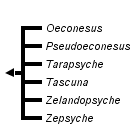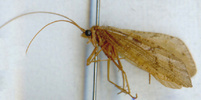Oeconescidae
Karl Kjer


This tree diagram shows the relationships between several groups of organisms.
The root of the current tree connects the organisms featured in this tree to their containing group and the rest of the Tree of Life. The basal branching point in the tree represents the ancestor of the other groups in the tree. This ancestor diversified over time into several descendent subgroups, which are represented as internal nodes and terminal taxa to the right.

You can click on the root to travel down the Tree of Life all the way to the root of all Life, and you can click on the names of descendent subgroups to travel up the Tree of Life all the way to individual species.
For more information on ToL tree formatting, please see Interpreting the Tree or Classification. To learn more about phylogenetic trees, please visit our Phylogenetic Biology pages.
close boxIntroduction
This is a small family of 6 genera and fewer than 20 described species. Tillyard (1921) described the family originally as a tribe of Sericostomatinae. The monotypic genus Tascuna Neboiss is found in Tasmania. The other genera, Oeconesus McLachlan (5 species), Pseudoeconesus McLachlan (9 species), Zelandopsyche Tillyard (2 species) and the monotypic genera Zepsyche McFarlane and Tarapsyche McFarlane, are endemic to New Zealand. Larval cases are of plant and rock materials (Cowley 1978). Larvae feed on plant debris in small forested streams (Cowley 1978, Winterbourn & Davis 1976). (From Holzenthal et al., 2007)References
Cowley, D.R. (1978) Studies on the larvae of New Zealand Trichoptera. New Zealand Journal of Zoology, 5, 639–750.
Holzenthal R.W., Blahnik, R.J., Prather, A.L., and Kjer K.M. 2007. Order Trichoptera Kirby 1813 (Insecta), Caddisflies. In: Zhang, Z.-Q., and Shear, W.A. (Eds). 2007 Linneaus Tercentenary: Progress in Invertebrate Taxonomy. Zootaxa. 1668:639–698.
Tillyard, R.J. (1921) Studies of New Zealand Trichoptera, or caddis-flies: no. 1. Description of a new genus and species belonging to the family Sericostomatidae. Transactions of the New Zealand Institute, Wellington, 53, 346–350.
Winterbourn, M.J. & Davis, S.F. (1976) Ecological role of Zelandopsyche ingens (Trichoptera: Oeconesidae) in a beech forest system ecosystem. Marine and Freshwater Research, 27, 197–215.
Title Illustrations

| Scientific Name | Zelandopsyche maclellani |
|---|---|
| Location | New Zealand |
| Specimen Condition | Dead Specimen |
| Identified By | O. Flint Jr. |
| Life Cycle Stage | Adult |
| View | Lateral |
| Collection | NMNH |
| Collector | Flint |
| Source Collection | Barcode of Life Database (BOLD) |
About This Page
Karl Kjer

Rutgers University, New Brunswick, New Jersey, USA
Correspondence regarding this page should be directed to Karl Kjer at
Page copyright © 2010 Karl Kjer
 Page: Tree of Life
Oeconescidae.
Authored by
Karl Kjer.
The TEXT of this page is licensed under the
Creative Commons Attribution-NonCommercial License - Version 3.0. Note that images and other media
featured on this page are each governed by their own license, and they may or may not be available
for reuse. Click on an image or a media link to access the media data window, which provides the
relevant licensing information. For the general terms and conditions of ToL material reuse and
redistribution, please see the Tree of Life Copyright
Policies.
Page: Tree of Life
Oeconescidae.
Authored by
Karl Kjer.
The TEXT of this page is licensed under the
Creative Commons Attribution-NonCommercial License - Version 3.0. Note that images and other media
featured on this page are each governed by their own license, and they may or may not be available
for reuse. Click on an image or a media link to access the media data window, which provides the
relevant licensing information. For the general terms and conditions of ToL material reuse and
redistribution, please see the Tree of Life Copyright
Policies.
- First online 17 July 2010
- Content changed 20 July 2010
Citing this page:
Kjer, Karl. 2010. Oeconescidae. Version 20 July 2010 (under construction). http://tolweb.org/Oeconescidae/14608/2010.07.20 in The Tree of Life Web Project, http://tolweb.org/







 Go to quick links
Go to quick search
Go to navigation for this section of the ToL site
Go to detailed links for the ToL site
Go to quick links
Go to quick search
Go to navigation for this section of the ToL site
Go to detailed links for the ToL site